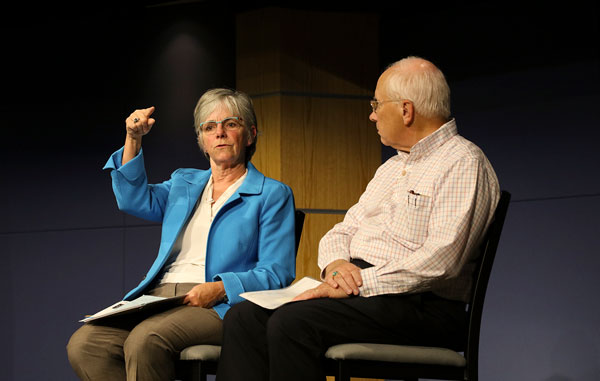
Laboratories Director Steve Younger and Chief Research Officer Susan Seestrom took the stage at the Steve Schiff Auditorium Aug. 26 to discuss “discovery science” and what it means for Sandia. The talk was the latest installment of the New Research Ideas Forum.
Both Steve and Susan leaned on lessons from the past to talk about the Labs’ future.
“The United States has, for the past 20 years or more — actually since the end of the Cold War — enjoyed technological supremacy,” Steve said during opening remarks. “And we’ve gotten used to that, and we’ve thought: ‘Well, this is normal.’”
Steve pointed out that this status is being challenged by other countries’ heavy investments in technology, and it can be lost if we don’t change the way we approach research.
“In my opinion, there is a Sputnik moment coming our way,” he said, referring to the Soviet satellite that challenged the U.S. space program’s presumed superiority, sparking the space race of the ‘50s and ‘60s.
Discovery science, he proposed, is the way Sandia will continue to out-innovate the nation’s adversaries. He described this as fast-moving, risky research driven by the merits of the questions being asked rather than the likelihood of the project’s success.
“We’re not going to achieve our national security objectives by building walls around technology. We’re going to achieve our national security objectives by running faster than anybody else,” he said.
Susan also summoned images of the past in her opening remarks while elaborating that discovery science also means truly understanding experiments.
“You have to spend time to understand the unexpected when it comes up, and then combine your physical insight into what happened with the fact that you recognized it wasn’t what was expected,” she said. “And we’re only here — in this laboratory, in the nuclear weapons complex — because a set of extraordinary scientists did that in the early 20th century.”
Susan cited Marie Curie’s discovery of the element thorium and Lise Meitner’s discovery of fission as examples of discovery science in action. She said true discovery science means inventing tools that give researchers new ways of examining our world and thoroughly investigating phenomena without necessarily knowing what will be found. Sandia ought to do basic research, she said; however, she maintained, the sweet spot is research informed by end-use for Sandia’s mission.
‘Now’s the time’
A question-and-answer period followed the opening remarks. Moderator Gil Herrera asked what creates the opportune timing to invest in discovery science at Sandia.
“Now’s the time,” Steve said, noting the healthy budget Sandia currently enjoys.
Susan echoed his urgency but focused on concerns about the health of Sandia’s research program. She pointed to possible warning signs, including a low publication rate within the Laboratory Directed Research and Development program compared to labs with similar programs, as justification for changes.
Steve said later, however, that changes in culture and business practices might be necessary to enable more discovery science. He said he recognizes staff are busy with mission-directed work and may not have time and resources to pursue other interesting questions.
“We need to unwrap the axle,” he said.
A new hire who previously worked for Chevron asked if Sandia had initiatives in place to help employees think more agilely and start applying the principles that had been discussed. Steve said he believed practice over time would probably create more lasting change than any “magic bullet,” but that the LDRD program was the ideal engine for pushing this change.
Susan recognized Sandia’s business excellence office as especially knowledgeable in these matters and said large facilities like the Z machine or Microsystems Engineering, Science and Applications may have the best opportunity to apply such initiatives.
Sandia Fellows Gil Herrera, Katherine Simonson and Jeff Tsao orchestrated the event. They also organized a meeting immediately following the event, in which a group of senior scientists discussed what had been talked about on stage.
“The main session was more philosophical,” said Jeff, who led the second meeting, “while the post-hoc was more on the opportunities and challenges associated with the execution.”